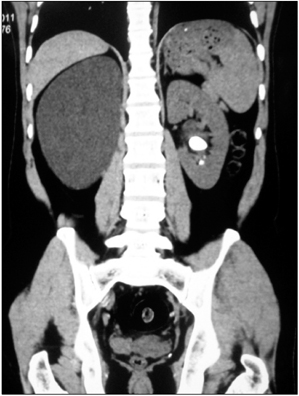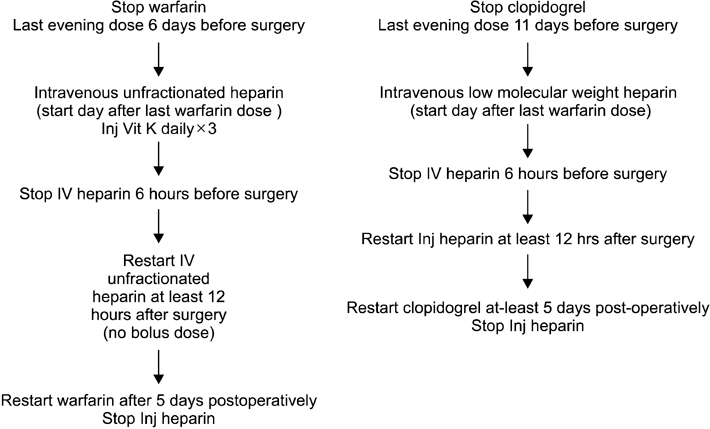Chonnam Med J.
2012 Aug;48(2):103-107. 10.4068/cmj.2012.48.2.103.
Percutaneous Nephrolithotomy in Patients on Chronic Anticoagulant/Antiplatelet Therapy
- Affiliations
-
- 1Department of Urology, KLES Kidney Foudation, KLES Dr. Prabhakar Kore Hospital & MRC, Belgaum, India. rajendranerli@yahoo.in
- KMID: 2172211
- DOI: http://doi.org/10.4068/cmj.2012.48.2.103
Abstract
- Percutaneous nephrolithotomy (PCNL) is an integral component in the management of large volume renal stone disease either as monotherapy or in combination with shock wave lithotripsy. Stone disease in patients on chronic anticoagulation/antiplatelet therapy, however, poses a difficult scenario. Bleeding is a major concern for any patient undergoing PCNL. We retrospectively analyzed our series of patients with renal calculi who were on chronic anticoagulant therapy and who underwent PCNL. We reviewed the case records of patients undergoing PCNL during the period from January 2005 to December 2011. We analyzed the changes in preoperative and postoperative hemoglobin, serum creatinine, and clotting parameters, as well as intraoperative and postoperative bleeding and thromboembolic complications. During the 5-year study period, a total of 36 patients (30 males and 6 females) with a mean age of 46.33+/-9.96 years (range, 29-61 years) who were on chronic anticoagulant/antiplatelet therapy underwent PCNL for urolithiasis. The mean size of the stone was 6.40+/-1.98 cm2 (range, 2.8-9 cm2). The mean operating time was 62.08+/-10.10 min. The bleeding was successfully managed in all patients and the anticoagulant/antiplatelet agents were restarted after an appropriate duration. The mean rise in serum creatinine at discharge was 0.05+/-0.03 mg/dl and the mean fall in serum hemoglobin was 1.63+/-0.77 g/dl. At 3 months after surgery, the stone-free rate was 100%. With careful preoperative care and regulation of anticoagulation/antiplatelet therapy and appropriate intraoperative management, PCNL can be performed safely and successfully in properly selected patients with renal calculi who are on chronic anticoagulant/antiplatelet therapy.
Keyword
MeSH Terms
Figure
Reference
-
1. Preminger GM, Assimos DG, Lingeman JE, Nakada SY, Pearle MS, Wolf JS Jr. AUA Nephrolithiasis Guideline Panel. Chapter 1: AUA guideline on management of staghorn calculi: diagnosis and treatment recommendations. J Urol. 2005. 173:1991–2000.
Article2. Klingler HC, Kramer G, Lodde M, Dorfinger K, Hofbauer J, Marberger M. Stone treatment and coagulopathy. Eur Urol. 2003. 43:75–79.
Article3. Lee WJ, Smith AD, Cubelli V, Badlani GH, Lewin B, Vernace F, et al. Complications of percutaneous nephrolithotomy. AJR Am J Roentgenol. 1987. 148:177–180.
Article4. Giusti G, Piccinelli A, Taverna G, Benetti A, Pasini L, Corinti M, et al. Miniperc? No, thank you! Eur Urol. 2007. 51:810–814.
Article5. Netto NR Jr, Ikonomidis J, Ikari O, Claro JA. Comparative study of percutaneous access for staghorn calculi. Urology. 2005. 65:659–662.
Article6. Kim SC, Kuo RL, Lingeman JE. Percutaneous nephrolithotomy: an update. Curr Opin Urol. 2003. 13:235–241.
Article7. Liatsikos EN, Kapoor R, Lee B, Jabbour M, Barbalias G, Smith AD. "Angular percutaneous renal access". Multiple tracts through a single incision for staghorn calculous treatment in a single session. Eur Urol. 2005. 48:832–837.
Article8. Stoller ML, Wolf JS Jr, St Lezin MA. Estimated blood loss and transfusion rates associated with percutaneous nephrolithotomy. J Urol. 1994. 152:1977–1981.
Article9. Davidoff R, Bellman GC. Influence of technique of percutaneous tract creation on incidence of renal hemorrhage. J Urol. 1997. 157:1229–1231.
Article10. Patterson DE, Segura JW, LeRoy AJ, Benson RC Jr, May G. The etiology and treatment of delayed bleeding following percutaneous lithotripsy. J Urol. 1985. 133:447–451.
Article11. Lee WJ, Smith AD, Cubelli V, Badlani GH, Lewin B, Vernace F, et al. Complications of percutaneous nephrolithotomy. AJR Am J Roentgenol. 1987. 148:177–180.
Article12. Kukreja R, Desai M, Patel S, Bapat S, Desai M. Factors affecting blood loss during percutaneous nephrolithotomy: prospective study. J Endourol. 2004. 18:715–722.
Article13. Kessaris DN, Bellman GC, Pardalidis NP, Smith AG. Management of hemorrhage after percutaneous renal surgery. J Urol. 1995. 153:604–608.
Article14. Kearon C, Hirsh J. Management of anticoagulation before and after elective surgery. N Engl J Med. 1997. 336:1506–1511.
Article15. Cannegieter SC, Rosendaal FR, Wintzen AR, van der Meer FJ, Vandenbroucke JP, Briët E. Optimal oral anticoagulant therapy in patients with mechanical heart valves. N Engl J Med. 1995. 333:11–17.
Article16. Heit JA. Perioperative management of the chronically anticoagulated patient. J Thromb Thrombolysis. 2001. 12:81–87.17. Fuster V, Ryden L, Asinger RW. ACC/AHA/ESC guidelines for the management of patients with atrial fibrillation. Executive summary. J Am Coll Cardiol. 2001. 38:1231–1266.
Article18. Schünemann HJ, Cook D, Grimshaw J, Liberati A, Heffner J, Tapson V, et al. Antithrombotic and thrombolytic therapy: from evidence to application: the Seventh ACCP Conference on Antithrombotic and Thrombolytic Therapy. Chest. 2004. 126:3 Suppl. 688S–696S.19. Watterson JD, Girvan AR, Cook AJ, Beiko DT, Nott L, Auge BK, et al. Safety and efficacy of holmium: YAG laser lithotripsy in patients with bleeding diatheses. J Urol. 2002. 168:442–445.
Article20. Ricchiuti DJ, Smaldone MC, Jacobs BL, Smaldone AM, Jackman SV, Averch TD. Staged retrograde endoscopic lithotripsy as alternative to PCNL in select patients with large renal calculi. J Endourol. 2007. 21:1421–1424.
Article21. Klingler HC, Kramer G, Lodde M, Dorfinger K, Hofbauer J, Marberger M. Stone treatment and coagulopathy. Eur Urol. 2003. 43:75–79.
Article22. Kefer JC, Turna B, Stein RJ, Desai MM. Safety and efficacy of percutaneous nephrostolithotomy in patients on anticoagulant therapy. J Urol. 2009. 181:144–148.
Article23. Kearon C, Hirsh J. Management of anticoagulation before and after elective surgery. N Engl J Med. 1997. 336:1506–1511.
Article
- Full Text Links
- Actions
-
Cited
- CITED
-
- Close
- Share
- Similar articles
-
- The Role of Novel Oral Anticoagulants and Antiplatelet Therapy after Percutaneous Coronary Intervention: Individualizing Therapy to Optimize Outcomes
- Recurrent Cardiac Tamponade Complicated by Coronary Intervention
- Percutaneous Nephrolithotomy in Kyphosis Patients
- Advances in percutaneous nephrostomy
- De-escalation strategies of dual antiplatelet therapy in patients undergoing percutaneous coronary intervention for acute coronary syndrome




